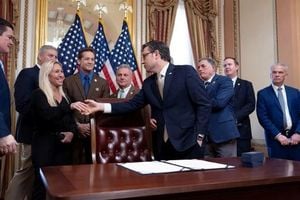The nation’s two largest teachers unions, the National Education Association (NEA) and the American Federation of Teachers (AFT), have come under renewed scrutiny following revelations that they collectively funneled over $43 million into left-leaning political groups and causes between 2022 and 2024. The findings, detailed in recent reports from both conservative media and watchdog organizations, have ignited a heated debate over the unions’ priorities, the use of teachers’ dues, and the broader implications for public education and American politics.
According to a report released by the nonprofit Defending Education, and cited by Fox News, the NEA and AFT together contributed a staggering $43.5 million to a range of organizations described as left-wing or far-left. These contributions, disclosed to the Department of Labor, have raised eyebrows not only for their size but also for the nature of the recipients. Among the most prominent was a half-million-dollar donation to the Sixteen Thirty Fund, which The Atlantic has called the “indisputable heavyweight of Democratic dark money.” The term “dark money” refers to political spending that is unregulated and unreported, a phenomenon that critics argue is often associated with right-wing groups, but which in this case is being wielded by progressive interests.
The Sixteen Thirty Fund, in particular, has drawn attention for its secretive payments to social media influencers—$8,000 a month, according to journalist Taylor Lorenz—to amplify Democratic Party messaging online. This strategy, blending grassroots activism with digital persuasion, has become a hallmark of modern political campaigns and signals a sophisticated approach to shaping public opinion.
But the Sixteen Thirty Fund was far from the only beneficiary. The unions also directed nearly $1 million to the Center for American Progress, a think tank founded by John Podesta and funded in part by George Soros. The Center has long been recognized as a policy hub for Democratic administrations, including those of Barack Obama and Joe Biden. Other recipients included the Trevor Project, an LGBT youth support group, as well as organizations fighting for gun control, promoting gender transition for minors, and opposing Republican judicial appointments.
“It is clear that the teachers unions’ priorities are advancing far-left politics and radical social justice issues, not the education of children,” said Defending Ed researcher Rhyen Staley, as quoted by Fox News. “This is a slap in the face to families and teachers who want to focus on helping students improve their reading and math skills. It is time that Congress acts to stop this obscene redistribution of public monies to advance left-wing identity politics.”
The report also highlighted significant contributions to other left-wing and "dark money" groups, including the Tides Network, New Venture Fund, and Future Forward, a group supporting Vice President Kamala Harris. Additionally, the unions gave substantial sums to the Democratic Governors Association and the Democratic Party’s House and Senate Majority PACs, further cementing their role as major players in the Democratic political ecosystem.
Critics argue that these expenditures are not only politically lopsided but also come at the expense of the unions’ core mission—representing teachers in the workplace. Aaron Withe, an expert on public-sector unions, told Fox News that the NEA spends 38% of its budget on left-wing groups and causes, while only allocating 10% to “representational activities” such as collective bargaining and workplace advocacy. “You’d think in light of the decline in union membership in recent years, that they’d start providing value to members that outweighs the cost of membership,” Withe observed. “Instead, they are appeasing the radical base of union members by advocating for men in women’s sports, transitioning minors, antisemitism and other radical ideological stances.”
Withe further suggested that the $43 million figure may only be the “tip of the iceberg,” noting that thousands of local and statewide teachers unions across the country are likely funding similar causes. The implication is that the true scale of political spending by teachers unions could be far greater than what has been publicly disclosed.
The unions’ financial clout is derived from mandatory dues paid by teachers, who, critics argue, have little choice but to contribute. The unions use their political influence to secure favorable terms in contract negotiations and to shape education laws and regulations, a dynamic that some see as a self-perpetuating cycle of power. As reported by The Atlantic, President Franklin Roosevelt himself once warned against allowing government employees to form traditional labor unions, arguing that “their employer is the whole people,” and that such arrangements risk undermining democratic accountability.
Supporters of the unions, however, contend that their political activities are a necessary counterbalance to well-funded efforts by right-wing groups to influence education policy. They argue that the unions’ advocacy for progressive causes reflects the values of many educators and is essential for protecting the rights of students and teachers alike. Yet, as the recent reports make clear, the unions’ political spending has become a lightning rod for criticism from across the political spectrum.
Neither the NEA nor the AFT responded to requests for comment from Fox News or other outlets by the time of publication. This silence has only fueled further speculation about the unions’ motives and the extent of their political entanglements.
It’s worth noting that the $43 million in contributions cited in the reports accounts only for money given to issue-oriented organizations and a handful of political action committees. It does not include the hundreds of millions of dollars that national, state, and local unions are estimated to spend each election cycle on direct political activities, advertising, and get-out-the-vote efforts. In other words, the unions’ influence may be even more extensive than the headline figures suggest.
The debate over teachers unions and their political spending is far from new, but the scale and transparency of recent disclosures have brought the issue into sharper focus. For families concerned about the direction of public education, and for teachers wondering where their dues are going, these revelations raise urgent questions about accountability and priorities. As Congress and the public grapple with these findings, the future of teachers unions—and their role in American society—remains an open question.
For now, the controversy surrounding the NEA and AFT’s multimillion-dollar political contributions shows no sign of abating, and the battle over the soul of public education continues to rage on.




